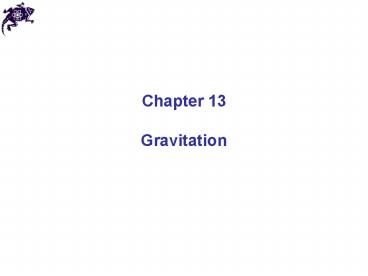Gravitation - PowerPoint PPT Presentation
1 / 29
Title:
Gravitation
Description:
Gravitational force (Newton's law of gravitation) ... Tycho Brahe/ Tyge Ottesen. Brahe de Knudstrup (1546-1601) First Kepler's law ... – PowerPoint PPT presentation
Number of Views:40
Avg rating:3.0/5.0
Title: Gravitation
1
Chapter 13 Gravitation
2
- Newtons law of gravitation
- Any two (or more) massive bodies attract each
other - Gravitational force (Newton's law of
gravitation) - Gravitational constant G 6.6710 11 Nm2/kg2
6.6710 11 m3/(kgs2) universal constant
3
- Gravitation and the superposition principle
- For a group of interacting particles, the net
gravitational force on one of the particles is - For a particle interacting with a continuous
arrangement of masses (a massive finite object)
the sum is replaced with an integral
4
Chapter 13 Problem 9
5
- Shell theorem
- For a particle interacting with a uniform
spherical shell of matter - Result of integration a uniform spherical shell
of matter attracts a particle that is outside the
shell as if all the shell's mass were
concentrated at its center
6
- Gravity force near the surface of Earth
- Earth can be though of as a nest of shells, one
within another and each attracting a particle
outside the Earths surface - Thus Earth behaves like a particle located at
the center of Earth with a mass equal to that of
Earth - g 9.8 m/s2
- This formula is derived for stationary Earth of
ideal spherical shape and uniform density
7
Gravity force near the surface of Earth In
reality g is not a constant because Earth is
rotating, Earth is approximately an ellipsoid
with a non-uniform density
8
Gravity force near the surface of Earth Weight
of a crate measured at the equator
9
- Gravitation inside Earth
- For a particle inside a uniform spherical shell
of matter - Result of integration a uniform spherical shell
of matter exerts no net gravitational force on a
particle located inside it
10
- Gravitation inside Earth
- Earth can be though of as a nest of shells, one
within another and each attracting a particle
only outside its surface - The density of Earth is non-uniform and
increasing towards the center - Result of integration the force reaches a
maximum at a certain depth and then decreases to
zero as the particle reaches the center
11
Chapter 13 Problem 20
12
- Gravitational potential energy
- Gravitation is a conservative force (work done
by it is path-independent) - For conservative forces (Ch. 8)
13
- Gravitational potential energy
- To remove a particle from initial position to
infinity - Assuming U8 0
14
- Escape speed
- Accounting for the shape of Earth, projectile
motion (Ch. 4) has to be modified
15
- Escape speed
- Escape speed speed required for a particle to
escape from the planet into infinity (and stop
there)
16
- Escape speed
- If for some astronomical object
- Nothing (even light) can escape from the surface
of this object a black hole
17
Chapter 13 Problem 33
18
- Keplers laws
- Three Keplers laws
- 1. The law of orbits All planets move in
elliptical orbits, with the Sun at one focus - 2. The law of areas A line that connects the
planet to the Sun sweeps out equal areas in the
plane of the planets orbit in equal time
intervals - 3. The law of periods The square of the period
of any planet is proportional to the cube of the
semimajor axis of its orbit
19
- First Keplers law
- Elliptical orbits of planets are described by a
semimajor axis a and an eccentricity e - For most planets, the eccentricities are very
small (Earth's e is 0.00167)
20
- Second Keplers law
- For a star-planet system, the total angular
momentum is constant (no external torques) - For the elementary area swept by vector
21
- Third Keplers law
- For a circular orbit and the Newtons Second law
- From the definition of a period
- For elliptic orbits
22
- Satellites
- For a circular orbit and the Newtons Second law
- Kinetic energy of a satellite
- Total mechanical energy of a satellite
23
- Satellites
- For an elliptic orbit it can be shown
- Orbits with different e but the same a have the
same total mechanical energy
24
Chapter 13 Problem 50
25
Answers to the even-numbered problems Chapter
13 Problem 2 2.16
26
- Answers to the even-numbered problems
- Chapter 13
- Problem 4
- 2.13 10-8 N
- (b) 60.6º
27
- Answers to the even-numbered problems
- Chapter 13
- Problem 20
- G(M1 M2)m/a2
- (b) GM1m/b2
- (c) 0
28
- Answers to the even-numbered problems
- Chapter 13
- Problem 32
- 2.2 107 J
- (b) 6.9 107 J
29
Answers to the even-numbered problems Chapter
13 Problem 54 (a) 8.0 108 J (b) 36 N































